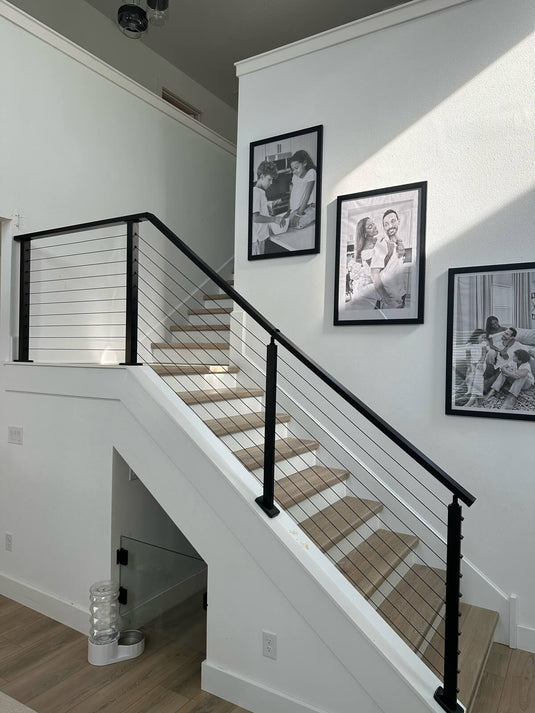TABLE OF CONTENTS
How to Make Stairs Safer for All Family Members: Elderly, Toddlers, and Pets
Statistics from the National Safety ouncil (NSC) show that stair accidents cause more than 1 million injuries and 12,000 deaths each year, half of which occur at home. Safety is always a top priority when designing and installing stairs, especially for household members with special needs. As modern, stylish designs gain popularity, floating stairs have become a favored option. While these stairs may appear less conventional and seemingly offer less support than traditional staircases, with the right safety measures in place, floating stairs can be just as safe.
Whether you’re concerned about elderly family members with limited mobility, toddlers who are just starting to explore their surroundings, or pets who might struggle with slippery steps, there are simple solutions you can implement to make safe step stairs. Let’s dive into the practical steps you can take today to make your safe stairs for all ages and stages of life.

Photo credit: Muzata customer
Why Stairs Are Unsafe
Falling down stairs can happen unexpectedly, but when stairs are defective or poorly maintained, accidents become far more likely—and often unavoidable. Stair-related injuries caused by such issues may result from a variety of factors, including:
● Broken or missing steps
● Structural failure or collapse
● Uneven riser heights
● Lack of anti-slip treads or materials
● Damaged stair surface materials or carpeting
● Cracked or uneven steps
● Missing, broken, or defective handrails
● Inadequate lighting
● Narrow or overly steep stairs
● Debris or clutter on stairs
● Water accumulation caused by poor design
How Do Handrails on Stairs Help Keep You Safe
Handrails are one of the most effective safety features for any staircase. Whether it’s a traditional staircase or a modern floating one, having a handrail can significantly reduce the risk of accidents. They provide essential support, especially when navigating stairs, making them crucial for enhancing stair safety.
To truly maximize the safety of your stairs, the design, placement, and material of the handrails must be thoughtfully considered:
Choose the Right Height
The height of the handrail is crucial for its functionality. It should typically be placed between 34 inches and 38 inches from the tread of the stair. This height range is optimal for most people, offering easy reach and sufficient support. Too high or too low can diminish its effectiveness and increase the risk of injury.
Select the Correct Material
Handrails come in a variety of materials, including wood, metal, and glass. Each material has its advantages, but they all should be durable and easy to grip. Metal handrails, for example, offer strength and stability, while wooden handrails are both aesthetically pleasing and comfortable to hold. For floating stairs, it's important to choose materials that complement the sleek, minimalist design while still ensuring maximum support.
Ensure Proper Placement and Design
Especially when designing handrails for floating stairs, the placement and structure must be carefully planned to maintain both safety and the modern aesthetic of the staircase. Handrails should run the entire length of the staircase and be continuous, with no interruptions. Additionally, they should be positioned to avoid obstructing the view of the floating design while offering a firm grip when needed. Consider a design that blends seamlessly into the staircase's overall look, whether it's a sleek metal rail or a more traditional wooden style.

Photo credit: Muzata customer
How to Make Stairs Safer for All Family Members
Stairs can be risky for certain groups, including the elderly, toddlers, and pets. By implementing simple safety measures, you can reduce these risks and ensure everyone can safely navigate stairs. In this section, we’ll discuss how to make stairs safer for these vulnerable groups with easy-to-apply solutions.
Making Safe Stairs for the Elderly
Install Handrails on Both Sides: Installing handrails on both sides of the stairs provides crucial support for the elderly, helping them maintain balance while climbing or descending. This added stability reduces the risk of falls, especially for individuals who may have mobility issues or weaker balance. It’s important to ensure that the handrails are at a comfortable height and securely fixed to the wall or staircase.
Use Non-slip Stair Treads: Non-slip stair treads are a simple but highly effective addition to improve stair safety for the elderly. These treads prevent slipping, particularly on smooth or hardwood floors that can become slick, especially in wet conditions. Look for treads made from high-quality rubber or textured materials that provide a firm grip. Alternatively, non-slip strips can be applied to each step for added security.
Improve Lighting: Proper lighting is essential to ensure that every step is clearly visible. For elderly individuals, low visibility can be a major hazard. Adding bright lights, especially at the top and bottom of the staircase, reduces the risk of missteps. Motion-sensor lights can be an excellent choice, as they activate automatically when someone approaches the stairs, ensuring that there’s no need to fumble for switches.
Making Safe Stairs for Toddlers
Install Safety Gates: Safety gates are essential for preventing toddlers from accessing stairs when unsupervised. Installing a sturdy gate at both the top and bottom of the stairs ensures that toddlers are kept safely away from potential hazards. Look for gates that are child-proof and easy for adults to open, but secure enough to prevent curious little ones from getting through.
Add Soft Padding: Although toddlers are naturally curious, they are still at risk of falls. Adding soft padding to the edges of stairs can help minimize injuries in case they do fall. Corner guards or foam padding along the edges of each step offer a cushioning effect that reduces the impact of a fall, helping to prevent bruises or more serious injuries.
Clear Stairs of Obstacles: Keep the stairs free from toys, shoes, or other items that could create tripping hazards. Toddlers often have unsteady steps, and cluttered stairs can increase the risk of accidents. Regularly check the stairs to make sure they are clear of any obstacles, ensuring a safe path for little feet. This also helps maintain a clean and tidy space for the family.

Making Safe Stairs for Pets
Install a Pet Ramp: For pets who are either very young or elderly, stairs can be difficult to navigate. Installing a pet ramp, particularly for high stairs, provides an easy alternative for them to ascend and descend without straining their muscles or joints. Pet ramps are gentle on their limbs and can be especially helpful for smaller breeds or older pets suffering from arthritis.
Keep Stairs Obstacle-Free: Pets, like toddlers, can be prone to tripping over items left on the stairs. Ensure that the stairs are kept free from clutter, such as pet toys, clothes, or other household items that could obstruct their path. A clear path ensures that your pet can safely navigate the stairs without tripping or getting hurt. Regular maintenance is key to preventing accidents and ensuring your pet’s safety while using the stairs.

How to Stay Safe While Walking on Stairs
Whether at home or in public spaces, stairs can pose a serious risk if we’re not careful. Staying mindful and following a few simple practices can go a long way in preventing accidents. Here are some essential tips to help you walk safely on stairs:
● Always Use the Handrail: Holding onto the handrail provides stability and helps prevent loss of balance, especially on steep or narrow steps.
● Watch Your Step: Avoid distractions like phones or conversations while going up or down. Focus on each step to avoid missteps.
● Keep Stairs Clear: Ensure the stairway is free of clutter, toys, bags, or other obstacles that could cause tripping.
● Don’t Rush: Take your time, especially when carrying items. Rushing increases the risk of slipping or missing a step.
● Ensure Proper Lighting: Make sure staircases are well-lit so that each step is clearly visible, especially at night.
● Wear Suitable Footwear: Shoes with non-slip soles can greatly reduce your risk of slipping, especially on smooth or polished stairs.
By following these tips, you can keep yourself—and others—safe while navigating stairs in any setting.
Conclusion
Stairs are a crucial element in any home, and ensuring they are safe for all the family members is vital. By incorporating features like handrails, non-slip treads, and proper lighting, you can enhance both the safety and functionality of your stairs while preserving their aesthetic appeal.
At Muzata, we specialize in designing floating stairs that blend beauty with safety for every member of your family. Whether you're designing a staircase for seniors, toddlers, or dogs, we can help you meet your needs without compromising on style or safety.
Get in touch with us today to discover how we can help you design stairs that are as safe as they are stunning!




